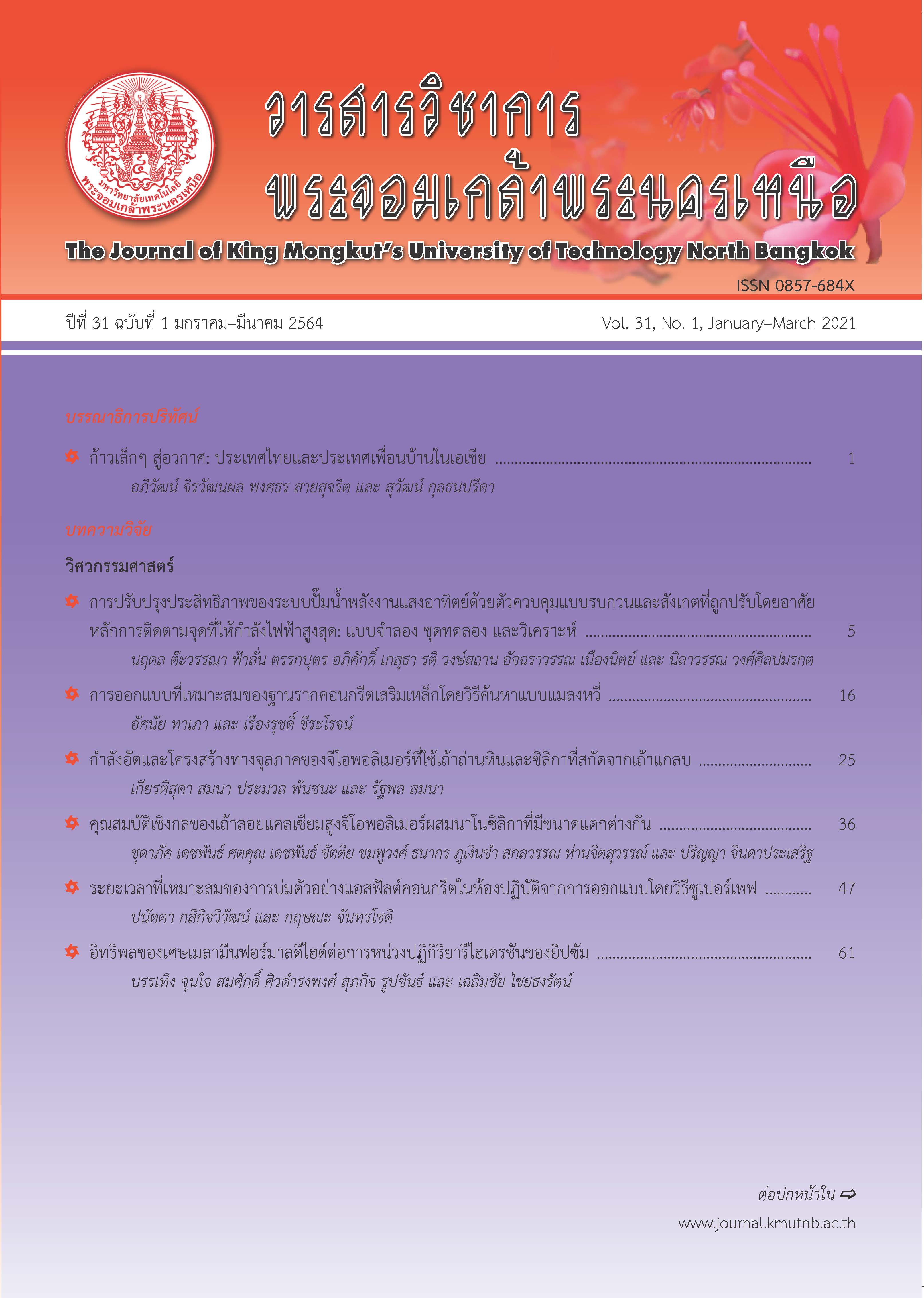ผลของการใช้ผงสีจาก Monascus purpureus หมักกับกล้วยน้ำว้าทดแทนไนไตรท์ในผลิตภัณฑ์แหนม
Main Article Content
บทคัดย่อ
งานวิจัยนี้เป็นการศึกษาพัฒนาผลิตภัณฑ์แหนมเติมผงสีจากการหมักกล้วยน้ำว้าด้วย Monascus purpureus โดยศึกษาหาความชื้นเริ่มต้นของกล้วยน้ำว้าที่ระดับต่างๆ (ร้อยละ 60, 70 และ 80) ที่เหมาะสมต่อการเจริญของ M. purpureus จากผลการวิจัยพบว่า ความชื้นเริ่มต้นของกล้วยน้ำว้าที่เหมาะสมที่สุดสำหรับการหมักคือ ร้อยละ 60 เนื่องจากมีลักษณะปรากฏที่พบเส้นใยไมซีเลียมสีแดงของเชื้อราปกคลุมทั่วชิ้นกล้วยหนาแน่นที่สุด และมีค่า Pigment yield (OD ที่ λmax ต่อกรัมน้ำหนักแห้ง) สูงที่สุด โดยสภาวะการอบแห้งที่เหมาะสมสำหรับกล้วยน้ำว้าหมักที่มีความชื้นเริ่มต้นร้อยละ 60 คือ อุณหภูมิ60 องศาเซลเซียส เป็นเวลา 150 นาที และทำการศึกษาการนำผงสีที่ได้มาทดแทนการใช้เกลือไนไตรท์ในผลิตภัณฑ์ 3 ระดับคือ ร้อยละ 0.15, 0.30 และ 0.45 ของน้ำหนักเนื้อ เทียบกับสูตรควบคุม จากการประเมินคุณภาพทางประสาทสัมผัส พบว่าผู้ทดสอบให้การยอมรับผลิตภัณฑ์แหนมเติมผงสีโมแนสคัสร้อยละ 0.45 ของน้ำหนักเนื้อมากที่สุด องค์ประกอบทางเคมีของผลิตภัณฑ์แหนมเติมผงสีโมแนสคัสคือ มีความชื้นร้อยละ 53.54 โปรตีนร้อยละ 11.01 ไขมันร้อยละ 26.91 ใยอาหารร้อยละ 0.30 เถ้าร้อยละ 2.01 และคาร์โบไฮเดรตร้อยละ 6.23 ด้านคุณภาพทางจุลินทรีย์พบว่า จำนวนจุลินทรีย์ทั้งหมดของแหนมเติมผงสีโมแนสคัส เท่ากับ 1.3 × 103 โคโลนีต่อกรัม และปริมาณยีสต์และราเท่ากับ 10 โคโลนีต่อกรัม
Article Details
บทความที่ลงตีพิมพ์เป็นข้อคิดเห็นของผู้เขียนเท่านั้น
ผู้เขียนจะต้องเป็นผู้รับผิดชอบต่อผลทางกฎหมายใดๆ ที่อาจเกิดขึ้นจากบทความนั้น
เอกสารอ้างอิง
[2] S. Eadmusik, “Utilization of agricultural residues from Monascus fermentation,” KKU Research Journal, vol. 19, no. 1, pp. 92–106, 2014 (in Thai).
[3] S. Jirasatid, “The production of monacolin K, yellow pigment and citrinin by Monascus purpureus on agro-industrial byproducts in solid-state fermentation,” Burapha University, National Research Council of Thailand, Chon Buri, Thailand, Grant no. 78/2558, 2015 (in Thai).
[4] W. Kanlayakrit, P. Suksamran, H. Sukbumrungsub, and K. Yaipon, “Study on initial moisture content of rice for red pigment production of Monascus purpureus in various cultivation scales,” in Proceedings of 53rd Kasetsart University Annual Conference: Science, Genetic Engineering, Architecture and Engineering, Agro-Industry, Natural Resources and Environment, 2015, pp. 995–1002 (in Thai).
[5] S. L. Wang, Y. H. Yen, W. J. Tsiao, W. T. Chang, and C. L. Wang, “Production of antimicrobial compounds by Monascus purpureus CCRC31499 using shrimp and crab shell powder as a carbon source,” Enzyme and Microbial Technology, vol. 31, no. 3, pp. 337–344, 2002.
[6] P. Pattanagul, R. Pinthong, A. Phianmongkhol, and S. Tharatha, “Mevinolin, citrinin and pigments of adlay angkak fermented by Monascus sp.,” International Journal of Food Microbiology, vol. 126, no. 1–2, pp. 20–23, 2008.
[7] I. Srianta, B. Hendrawan, N. Kusumawati, and P. J. Blanc, “Study on durian seed as a new substrate for angkak production,” International Food Research Journal, vol. 19 no. 3, pp. 941–945, 2012.
[8] S. Eadmusik, M. Laddee, and N. Choosuk, “Substitution of M. purpureus fermented soybean residues for Chinese-style sausage,” The Journal of KMUTNB, vol. 22, no. 3, pp. 22–31, 2012 (in Thai).
[9] S. T. Silveira, D. J. Daroit, V. Anna, and A. Brandelli, “Stability modeling of red pigments produced by Monascus purpureus in submerged cultivations with sugarcane bagasse,” Food and Bioprocess Technology, vol. 6, pp. 1007–1014, 2013.
[10] B. Leesuraplanon, “Study on the situation of using food additives in meat products. Nakhon Ratchasima Province 2560,” FDA journal, vol. 2561, no. 2, pp. 58–66, 2018.
[11] J. Tirasarot and C. Thanomwong, “The utilization of Ang-Kak for color in the emulsion fish sausage,” KKU Science Journal, vol. 42, no. 1, pp. 169–175, 2014.
[12] K. Rojsuntornkitti, N. Jittrepotch, T. Kongbangkerd, and K. Kraboun, “Substitution of nitrite by Chinese red broken rice powder in Thai traditional fermented pork sausage (Nham),” International Food Research Journal, vol. 17, no. 1, pp. 153–161, 2010.
[13] S. Inkioe, “Use of Monascus pigment (Angkak) as an alternative to nitrite in smoked sausage and Chinese sausage,” M.S. thesis, Graduate School, King Mongkuts Institute of Technology Ladkrabang, Bangkok, Thailand, 2001 (in Thai).
[14] S. Suksathits, P. Tangwatcharin, W. Petchkaew, and K. Pantong, “Production and characterization of flour, dietary fiber and resistant starch from Kluay Khai processing waste and their application in milk ice-cream,” Research project, Thaksin University, 2013 (in Thai).
[15] P. Naknaen, P. Charoenthaikij, and P. Kerdsup, “Physicochemical properties and nutritional compositions of foamed banana powders (Pisang Awak, Musa sapientum L.) dehydrated by various drying methods,” Walailak Journal of Science and Technology, vol. 13, no. 3, pp. 177–191, 2016 (in Thai).
[16] K. Tunsopon and D. Ochaikul, “Study on pigment production of Monascus purpureus TISTR 3090 on adlay solid state fermentation,” in Proceeding of the 49th Kasetsart University Annual Conference, Bangkok, Thailand, 2011 (in Thai).
[17] Official method of analysis, AOAC USA. Methods 925.10, 65.17, 974.24, 992.16., 2000.
[18] O. Erdogrul and S. Azirakrdo, “Review of the studies on the red yeast rice (Monascus purpureus),” Turkish Electronic Journal of Biotechnology, vol. 2, pp. 37–49, 2004.
[19] B. Yongsmith, Fermentative Microbiology of Vitamins and Pigments. Bangkok, Thailand: Kasetsart university press, 1999 (in Thai).
[20] C. Suksripaisaland and P. Theprugsa, “Use of tomato and ang-kak powder in Chinese sausage,” Journal of Science and Technology, vol. 27, no. 2, pp. 252–263, 2017 (in Thai).

